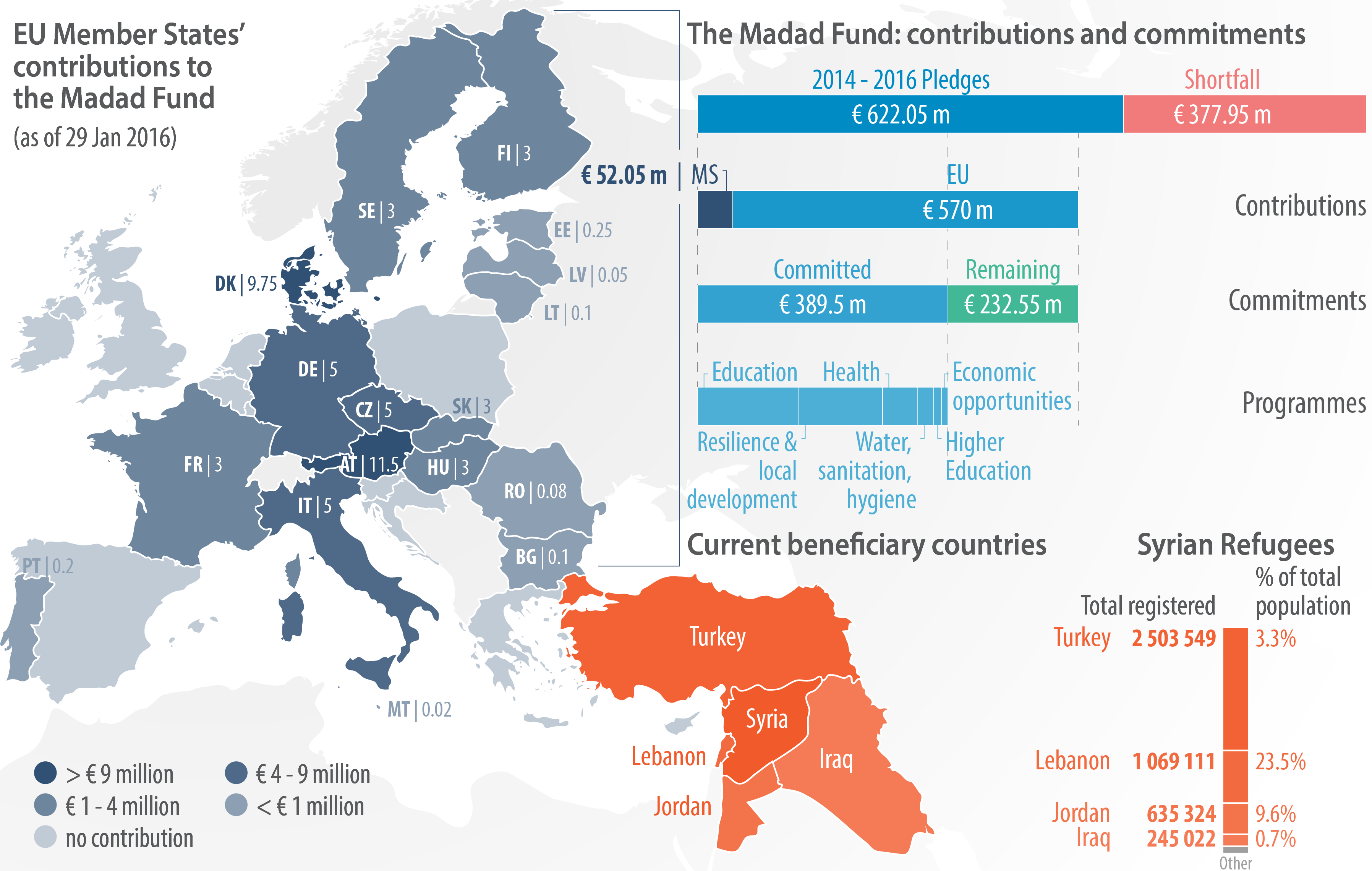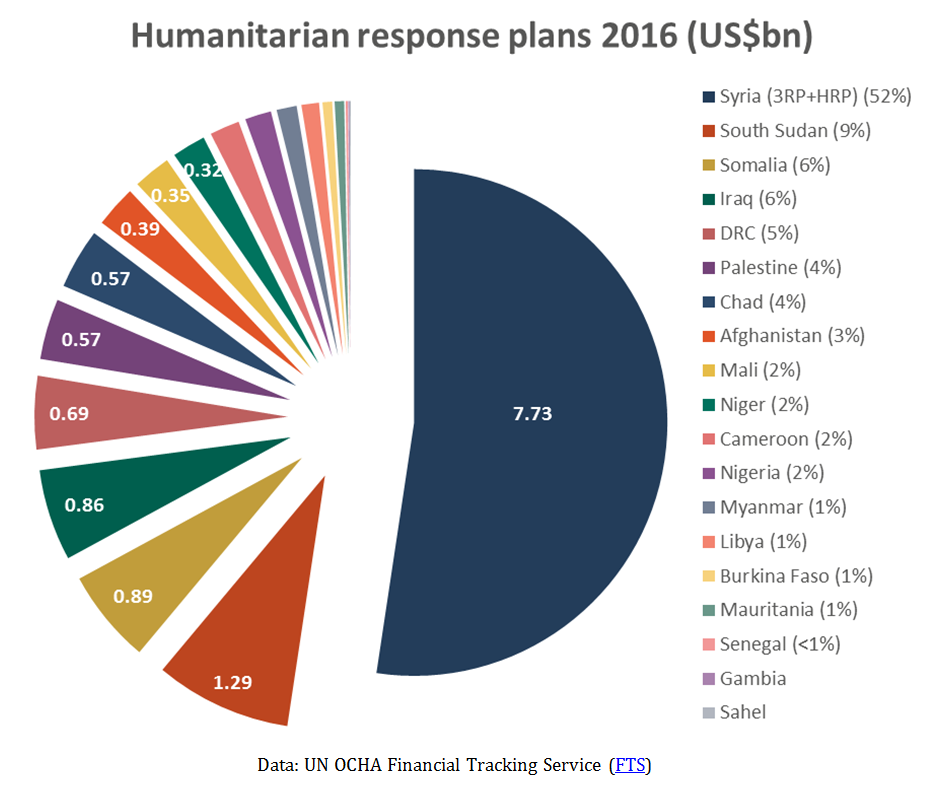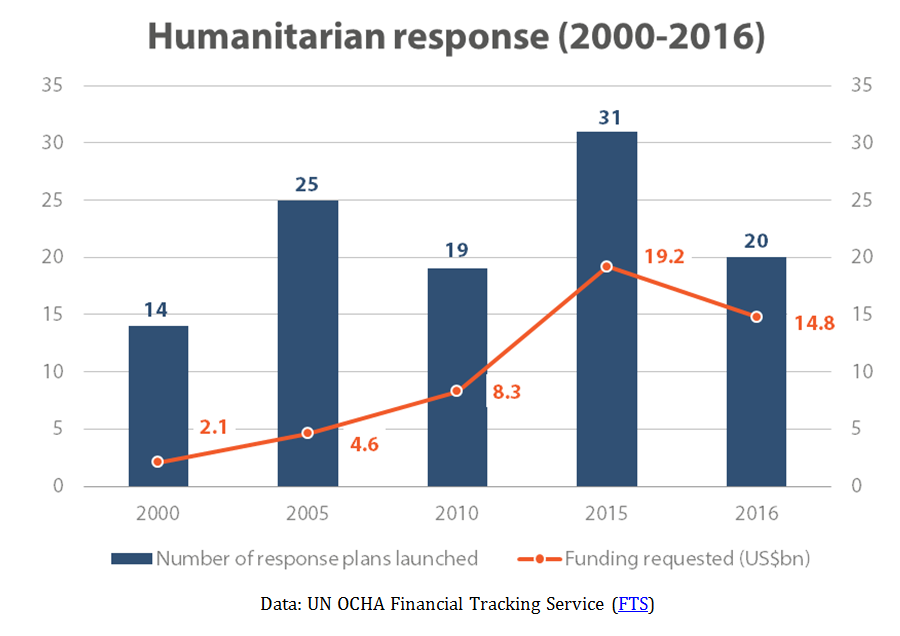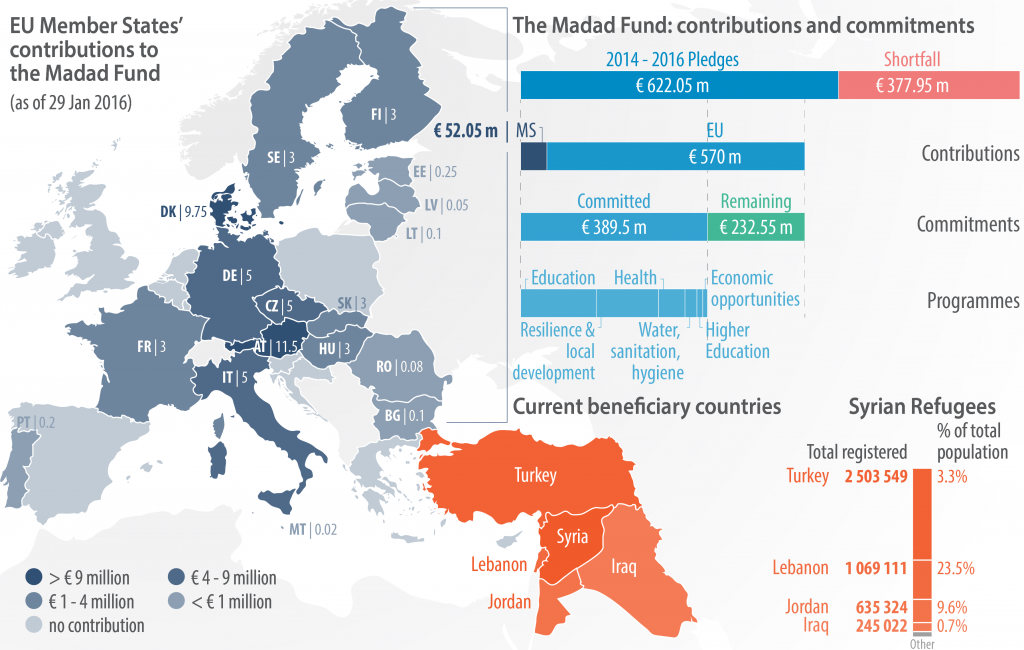Written by Patryk Pawlak,
Graphics by Christian Dietrich,
Since the beginning of the fighting in Syria in 2011, the conflict has forced over 4.5 million Syrians to flee the country and seek refuge across the region – primarily in Egypt, Iraq, Jordan, Lebanon and Turkey. Another 6.6 million people have been displaced internally. A political solution to the conflict in Syria still remains elusive, with air raids and military activities intensifying over the past weeks. Humanitarian access to 394 000 people living in besieged areas is also very difficult – and at times impossible.
Supporting Syria and the region

To address the dire humanitarian situation of Syrians and the host communities across the region, the UK, Germany, Kuwait, Norway, and the United Nations co-hosted on 4 February the ‘Supporting Syria and the Region 2016’ conference. The conference raised a record amount of over US$ 11 billion in pledges – US$5.8 billion for 2016 (around US$2 billion short of US$7.73 billion needed) and a further US$5.4 billion for 2017-20. An additional US$40 billion in loans on concessional terms were pledged by multilateral development banks and donors. The funding will go towards the immediate needs outlined in the 2016 Syria Humanitarian Response Plan (HRP) and the Regional Refugee and Resilience Plan (3RP) as well as humanitarian, resilience and development financial commitments (up to 2020). In addition, the funding will also go towards strengthening resilience of Syrians and the host communities by creating economic opportunities, jobs and educational opportunities. Jordan, Turkey and Lebanon – the main refugee-hosting countries – agreed to take steps to open up their labour markets to refugees and to improve regulation and the investment climate. It is estimated that as an outcome, up to 1.1 million jobs will be created for refugees from Syria and host country citizens in the region by 2018. In order to ensure that conflict in Syria will not result in a lost generation, the donors have also committed to put into quality education 1.7 million children by the end of the 2016/2017 school year.
Translating commitments into action
To date, the total humanitarian, development, economic and stabilisation assistance provided by the EU and its Member States to Syrians and Syrian refugees has amounted to over €4.4 billion. Following the proposal to increase the resources to tackle the refugee crisis, the EU adopted budgetary amendments that will bring the EU’s response in 2015 and 2016 close to €10 billion. At the London conference, the EU has pledged over €3 billion in additional funding. To allow for more flexible and speedy reaction in response to shifting needs, the European Union has also created the EU Regional Trust Fund in Response to the Syrian crisis (Madad Fund) with the overall objective to support the resilience of refugees from Syria, as well as of the communities hosting the refugees and their administrations.

Since the beginning of the crisis in 2011 the EU has gradually scaled up its support to countries in the region. In Lebanon, the European Commission’s assistance alone has reached almost €546 million, including more than €269 million from the humanitarian budget. In Jordan, Commission assistance amounts to some €580 million for Syrian refugees and host communities and is spent primarily on food aid and the provision of clean water and sanitation, as well as health services and protection. The biggest share of the funding is destined for assistance to Turkey. In November 2015, the EU committed to provide Turkey with €3 billion – to be coordinated by the Refugee Facility for Turkey – in addition to €175 million for Syrian and Iraqi refugees already provided since the beginning of the crisis, including the above humanitarian aid as well as longer-term assistance. The Joint Action Plan which was endorsed by EU leaders on 15 October 2015 identifies a series of collaborative actions to be implemented as a matter of urgency by the EU and Turkey aimed at providing more coordinated help to people in need of protection in Turkey. Finally, in order to better respond to humanitarian challenges along the Western Balkans route, the European Commission agreed to release €13 million destined primarily for refugees in Serbia and the former Yugoslav Republic of Macedonia, bringing the total amount of the EU humanitarian aid to the Western Balkans to €21.74 million.
Humanitarian response beyond Syria

The conflict in Syria has its roots in structural and economic problems that were already widespread in Syria in the early 2000s. Prior to the violent uprising of 2011, the countries of the greater Fertile Crescent had experienced one of the most severe droughts in history. The international community was slow to respond to the appeals by major donor organisations: according to the UN Office for the Coordination of Humanitarian Assistance (UN OCHA), as of June 2010, only 33% of the required assistance had been provided. Today, many countries around the world face similar challenge. According to the UNHCR, fifteen new conflicts have broken out or have reignited in the past five years. The number of conflicts that last longer than five years is also growing. Even though there is no general trend, it is worth noting that the number of crises requiring humanitarian response in 2015 was more than double compared to fifteen years ago, while the amount of requested funding has increased almost ten times. In 2015, UN OCHA has launched 31 humanitarian response plans for the total amount of US$19.2 billion, out of which 64% have been funded. At the same time, while certain crises have attracted donors’ attention – notably Syria, Iraq, Afghanistan or Nepal – others have remained seriously underfunded, including Gambia (5%), Sahel region (15%), Senegal (21%), Burkina Faso (31%) or Mali (35%). The situation in 2016 does not look much different. The total funding requested at the beginning of the year amounts to US$14.8 billion but this amount is likely to be revised upwards. The response plans for Syria will consume over 50% of that amount. In practical terms, this potentially implies fewer resources for other countries, including other hotspots like Mali, Niger, Cameroon or Libya.











Be the first to write a comment.